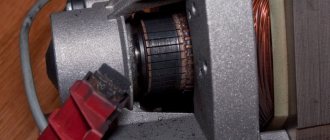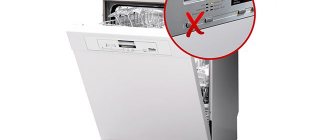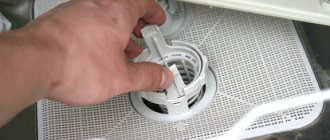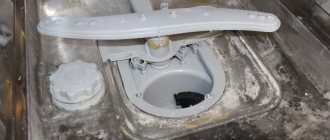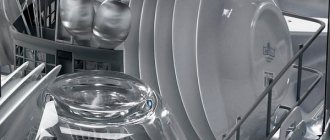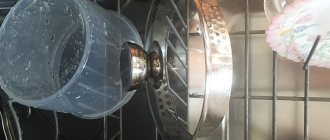When a “dishwasher” turns into a mouse - probable reasons
If for the housewife such a situation is force majeure, then for the ALM-remont specialists it is a normal case. The first step is to find out the cause of the squeaking noise, and then repair the dishwasher.
The reasons for a continuous beep can be very different:
- the filter (inlet or outlet) is clogged;
- the control unit is broken or the firmware needs to be reinstalled;
- there is a leak and the sensor has tripped;
- special products have run out (rinse aid, salt);
- The heating element has failed;
- the hoses are clogged or the pump is faulty;
- bearings “fly”;
Aquastop worked
Aquastop is a protective system that protects against leaks. It is available in many of the latest dishwashers from most manufacturers. For example, Bosch (Bosch), Hotpoint Ariston, Kandy, Siemens, Electrolux. On a number of models, data about the problem and the reason for the system operation is displayed in the form of error codes on the control panel. This makes it easy to determine the reason why the dishwasher beeps in the middle of the program. If the PMM does not have an Aquastop system, diagnostics are needed.
The door is not closed tightly
The device door is equipped with a lock that protects against leaks. If it is closed, the door lock signal is sent to the control module. After which the dishwasher starts working. When the lock is broken, the door cannot lock until it clicks. The module does not receive a signal about blocking; accordingly, the program will not start and water will not be drawn.
You can replace a broken lock yourself. To do this, disconnect the machine from the network, unscrew the front panel and the broken door lock. Then install a new lock and screw the panel back.
Filter clogged
To protect equipment from debris, food, and dirt, an inlet valve filter is installed. It needs to be changed or cleaned periodically. When water is slowly drawn into the machine or does not flow at all, the reason that the device begins to squeak is most likely due to a clogged filter. You can clean it yourself or call a professional.
Before cleaning, turn off the water. Unscrew the hose and remove the filter. It is located at the inlet of the intake valve. Rinse the mesh under running water. If there is a lot of dirt, then clean it with a needle or dip it in a solution of citric acid for 1 hour . The solution is prepared from 30 g of acid and 1 liter of water. The cleaned filter is installed in place and the hose is connected.
Sensor malfunctions
Dishwashers have different sensors that are responsible for monitoring the operation of all stages of the washing programs. With their help, the condition and level of water, temperature are controlled.
Let's look at typical error codes using the example of Electrolux dishwashers, which are caused by a malfunction of the sensors:
- 11 flashes (code ib0) – error in the turbidity sensor, which monitors the condition of the water using a light beam.
What can a squeaking dishwasher signal?
Our experts do not recommend turning a blind ear to such obvious requests for help from your equipment. After all, most often an irritating squeak indicates that some kind of breakdown has occurred inside the device or that an unusual situation has arisen, which should be sorted out immediately.
So, the squeak of the dishwasher can signal the following:
- filters are clogged
. To continue to function correctly, they need urgent cleaning. Otherwise, the machine may completely fail and require subsequent expensive repairs. The filter is located under the rocker arms and you can clean it yourself. To do this, you need to disconnect the device from the network, unload it from the dishes, thoroughly blot all remaining liquid and carefully remove the clogged part. You can clean the filter from greasy deposits using homemade means. For example, soak it for several hours in a solution of citric acid, and then rinse thoroughly under running water. This procedure should be performed at least once every few months, without waiting for a sound signal from your kitchen assistant. By the way, you also need to remember about the inlet filter, which is located on the water supply valve, and wash it from time to time to remove debris and rust. - The special detergents (conditioner and/or salt) have run out.
As an additional notification of such a problem, in addition to a squeak, special sensors may also flash. Products must be immediately topped up or poured into the compartments designated for them. - The heating element has failed.
Excessively hard water and a lack of salt lead to the fact that the heating element of the dishwasher and its insides become covered with a thick coating of scale over time. This crust gradually destroys the heating element and disables it, as a result of which the device begins to work incorrectly. It does not heat water to the required temperature, does not completely dissolve detergents, does not dry dishes, etc. The part should be replaced with a new spare part. - The pump has broken down or the pipes are clogged
. The hoses need to be cleaned and a new pump installed. If you can try to solve the first part of the problem on your own, then the second part should be entrusted to specialists. Please also take into account that by contacting a specialized service center, you will not need to look for the necessary spare part yourself. The parts needed for repair (high-quality and original), and at very reasonable prices, will be immediately delivered by employees of the service company to the place where the repair work is performed. - There is a water leak
. In this case, you should immediately disconnect the device from the network and call a specialist to fix the problem. - The software module has failed
. It is subject to flashing or replacement. The decision after a complete diagnosis of the device is made by a specialist.
Sometimes it happens that the dishwasher is working without failure and suddenly starts humming and making strange sounds. Despite the fact that minor breakdowns can be repaired on their own, it is better to seek help from a specialist who will disassemble the device, determine the fault and, if necessary, replace the broken or worn part.
Frequent causes of Bosch dishwasher breakdowns
If problems with operation began after purchasing the machine, pay attention to the settings. Is the work organized correctly? The correct connection of communications, inlet and drain hoses is important.
Which breakdowns happen more often than others:
- The equipment does not start . The indicators on the panel do not light up, the system does not respond to key presses.
- The Aquastop protection is triggered. The reason is water leaking into the pan or a malfunction of the float sensor.
- Water is not drained or collected . The problem is that the filters and ducts are clogged. Faulty circulation pump or pump.
- The program froze after the wash started . Clogged water inlets, broken electronic controls. There may also be a malfunction of the hatch lock.
Problems may appear as an error code on the screen. The electronic board is connected to all nodes through wiring. If one of them does not respond or respond to signals, self-diagnosis starts. You will find a decoding of the code in the instructions or in the publication “Bosch Dishwasher Error Codes”.
Main fault codes:
- E01/F01 - electronics failure, breakdown on the heating element body.
- E09/F09 - the heating element is malfunctioning.
- E3/F3 - water is not poured into the hopper.
- E22/F22 - clogged filters.
- E24/F24 - E25/F25 - problems with draining waste fluid.
- E15/F15 - the Aquastop system has activated.
- E27/F27 - power surges have been detected in the network.
For what reasons does the “faucet” on the panel light up or blink?
In the article “Dishwasher Indicators and Icons,” we described their meaning in detail.
- If the “faucet” light on the control panel comes on (next to the water supply button), and the dishwasher is working normally, everything is fine. This means that water for washing has begun to flow into the car.
- If you notice that the water supply indicator is on or flashing, while the machine beeps, and water does not enter the hopper, there are problems.
The explanation of this problem in the instructions sounds like this: there is no water supply. What could be the reason:
- The inlet filter is clogged.
- There were problems with the fill valve (broken, clogged).
- Incorrect connection of the drain system. Self-draining occurs.
- The water sprayer in the chamber is faulty.
All of the above signs may be indicated by code E15. If error E15 is on the PMM display and a tap is shown, there may be a problem with the Aquastop leak protection.
In various models of Bosch dishwashers, it can be full or partial.
Due to the leak, water enters the pan of the machine. With full protection, there is a float sensor that is triggered. As a result, a fault code is displayed on the display.
When the protection is partial, there is an absorbent sponge in the inlet hose. As soon as a leak occurs, the sponge is saturated with water and blocks access to the system. Read more about “Aquastop” for the dishwasher in a separate article.
Important! A large amount of foam can lead to leakage and tripping. Control the amount of detergent.
How to fix a dishwasher yourself?
There are two typical problems with Bosch PMM models. They are associated with water. Users often complain about the appearance of the E15 code on the display. This indicates that the Aquastop protection has been triggered. But it's not always a matter of leakage. Follow these steps:
- Tilt the PMM body back and look into the pan.
- If there is indeed water accumulated there, drain it.
- Return the float switch to the "Off" position.
Sometimes the cause of operation is incorrect placement of the inlet hose gasket. It may have moved during installation. Therefore, make the connection according to the user manual.
Dishwasher won't turn on
Have you connected your machine to the network, pressed the "Power" button, but nothing happens? The lights on the panel do not light up and no sound signals are heard. Things to check:
- Network wire. Sometimes it bends if it is pressed against the body of the dishwasher during rearrangement. If you notice damage to the insulation, do not make homemade twists. This approach can lead to a fire. Replace the cord immediately.
- Fork. The presence of melts and burns indicates a breakdown. Install the correct element.
- Socket. To check its functionality, connect another device. Works? This means the socket is working.
It is worth checking the surge protector (capacitor). It is located near the engine. A visual inspection should alert you to swelling and burns. The part must be replaced. You can buy it inexpensively in an online store.
Leave problems with electronics and control unit to the specialist. Here you need accurate diagnostics, which is carried out with a multimeter.
Problems with water intake and drainage
In case of such a problem, simple carelessness should be ruled out. So, it's worth checking:
- Is the shut-off valve open? Perhaps it was accidentally blocked.
- Is the inlet hose level? If it is bent or pinched by a foreign object, water will not flow.
When installing a hose with Aquastop protection, you need to monitor its operation. When the system is triggered, the absorbent becomes saturated with moisture, causing it to block the passage. This is a one-time protection, so you need to completely change the hose.
It is important to service your dishwasher at least once every 1-2 weeks.
Maintenance includes cleaning the system from debris:
- Turn off the water supply.
- Disconnect the hose from the housing.
- Take out the filter mesh.
- Rinse it free of clogs.
- Check the operation of the intake valve. Inspect its holes. When debris gets in, the passage becomes clogged, making it difficult for the membrane to move. It does not open and no liquid flows.
If there are problems with drainage, the pump does not necessarily break. Check parts for blockages:
- Open the camera door.
- Remove the baskets from the hopper.
- There is a filter at the bottom.
- Unscrew and clean the part.
- Check the pump impeller. Pieces of food entering through the filter can block its rotation.
- Remove water from the hole.
- Remove the cover by pulling it towards you.
- Wear gloves and remove the clog.
Watch a video on cleaning equipment:
Couldn't fix your machine by cleaning? Then diagnose the pump. The node is located at the bottom of the body. If there is a problem, just disconnect the wiring of the part, turn it and remove it from its place. After this, a new node is installed.
Heating fault
The first sign of heating problems is poor dishwashing. Fat does not dissolve in cold water, so you will remove wet but dirty utensils from the chamber. Diagnostics will help to accurately determine the cause of the problem. You need to check:
- A heating element;
- Temperature sensor;
- Their wiring and control triacs on the board.
Replacing the heating element in Electrolux PMM models is complicated by the presence of a non-separable heating block. Buying a replacement part will cost 3000-4000 rubles. Think about whether the game is worth the candle. If the equipment is already old, it makes sense to add money to a new dishwasher rather than buy a unit.
Have you decided to make a replacement? Then here is the sequence of steps for disassembling the PMM:
- Unplug the machine;
- Shut off the water supply and disconnect communications;
- Remove the baskets from the hopper;
- Remove the filter and water at the bottom;
- Unscrew the five screws securing the heater;
- Turn the body on its side;
- Remove the bottom;
- The block is connected to a circulation pump;
- Turn off the wiring, release the clamps;
- Rotate the block and disconnect it from the pump;
- Install the new unit in reverse order.
To avoid problems with network outages, connect a voltage stabilizer.
The machine does not wash dishes well
Problems with washing are possible when:
- poor supply of detergents;
- overloading the machine with dishes;
- blocking the sprayer;
- circulation pump malfunction.
Check the powder supply simply. Open the cuvette - if the remains of the tablet are visible in it, it means that water is not entering the compartment well. Check the placement of dishes in the hopper. Maybe a large plate is blocking the compartment, or the supply hose is clogged. Clean the cuvette after each wash to prevent detergent from accumulating in it.
Overload interferes with fluid circulation. When one device overlaps another, water does not wash the surface. There must be a gap between the plates for high-quality washing.
The rotation of the rocker arm, again, can be blocked by the plate. There may be a blockage or foreign object in the way. Clean the sprayer holes - nozzles.
After this, the pump is inspected. If it breaks and does not pass liquid, the unit needs to be replaced. The case will need to be disassembled. Remove the bottom, disconnect the pipes leading to the pump. An example of the repair is shown in the video:
Leak in the system
Damage or corrosion of the unit body leads to leakage. Although this is rare, it is not recommended to do any soldering yourself. Such repairs will not last long, so you will have to completely replace the body.
When Aquastop is activated, water may end up in the sump or leak from the hose connections. Inspect the following items:
- Hose fastenings. Tighten the clamps tighter.
- Pump gasket. If worn, install a new element.
- Door seal. Loss of tightness leads to leakage. Open the door, remove the old seal and install the new one.
Check to see if the pallet is damaged. Then it’s better to put a whole stand. If the float sensor malfunctions, a working part is installed.
Washing does not start
In such cases, the machine turns on, the indicator lights up, but the wash does not start. Or the program freezes. What is the reason and how to repair the equipment:
- System failure. If the dishwasher does not work normally after a power outage, reboot.
- The car door is not closed tightly or the lock is faulty.
Let's look at the last problem in more detail. The lock secures the door electronically. The tightly closed door should click, after which water intake and washing begin. Press it tighter. If the lock does not work, it needs to be replaced.
- Open the dishwasher door.
- Remove the screws from the inside.
- Open the outer panel slightly.
- Disconnect the lock wiring and install a new element.
Closing problems can also arise for the following reasons:
- Deformation of the sealing lip. Replace the seal.
- Incorrectly installed utensils. Check the arrangement of objects in the chamber, push the trays deeper.
- The dishwasher body is not installed level. The PMM should be located on a hard, flat surface, strictly level. Tilting the cabinet may cause the door to not seal properly.
Blockages in the filling path lead to the suspension of the PMM operation. Clean the systems to ensure normal water flow into the hopper.
What repairs will be needed if the ELECTROLUX dishwasher beeps and the error flashes?
Even if the error is displayed and the cause of the failure can be determined by its number, professional diagnostics with personal inspection and dismantling of components will still be required. If the control unit is faulty, any error can occur.
After diagnostics, the technician will replace the heating element, pump, clean the pipes or reflash the system. If necessary, he will install a new control unit. As a rule, large repair costs are not required: more often the error is displayed for trivial reasons that can be easily eliminated without the help of others.
Error i50 (5 blinks of the indicator) in the dishwasher
Dishwashers have recently begun to appear more and more often in our kitchens. Many who have not encountered the use of such a useful device still do not understand how much a dishwasher can simplify such a routine process as washing dishes. Today, almost all manufacturers of large household appliances have launched production of this indispensable device.
Dishwashers from the Swedish brand Electrolux can be considered one of the leaders in quality and reliability. In the line of this company there are models equipped with a digital display, as well as options with LED indication. Depending on how information visualization is implemented in a particular model, errors and processes can be displayed in the form of a special code or using cyclic blinking of indicators at a certain frequency and intervals.
The software developers for devices of this brand took care to make these codes as unified as possible. Therefore, the codes in the letter expression have a corresponding designation in the indicator expression and are deciphered in the same way. This method of reporting errors is well understood by both the user and the service center specialist. The only thing you need to have on hand in order to understand the malfunction is deciphering the error codes. In this article we will look at what an Electrolux dishwasher signals by showing the i50 code on the display or flashing the indicators five times.
What can you do yourself?
This error applies to both freestanding and built-in models. If the code i50 appears on the display, then before contacting a specialist, you can try to do the manipulations recommended by the manufacturer. The first thing you can do is try to reset the settings to make sure that this is not a random glitch.
To do this, you need to disconnect the device from the network, wait one minute and turn it on again. After connecting to the network, you need to try to select a program and launch it. If everything works and there are no more errors, then the problem is solved. If the code appears on the display again, you need to check whether it matches the previous one.
In a situation where resetting errors does not help, you will have to contact a service center.
Solving the problem with the involvement of a specialist
This problem should be addressed to an authorized service center. This is due to the fact that the error is interpreted as a malfunction of the control unit, and specifically the triac that controls the circulation pump. This problem may be accompanied by extraneous sounds, because A “stuck” triac causes the pump to rotate at maximum speed. If the problem is not solved in time, the latter will also fail.
The cause of this malfunction is most often a voltage drop in the electrical network. Often this breakdown is disappointing for the device, since repairing the control unit at a service center is quite expensive, and there is no point in contacting private technicians with such a problem.
You may encounter scammers who will ask for a seemingly smaller amount, but will not always repair the device. It is easier to prevent the occurrence of this breakdown even at the stage of purchasing and installing the machine by installing a voltage stabilizer. Well, if it does occur, then you shouldn’t try to save money by repairing an old device.
It is better to purchase a new dishwasher and make sure that this problem does not arise in the future.
New Electrolux equipment in the company store
If your dishwasher is many years old or it does not suit you in some respects, then you should take a closer look at new devices from a well-known Swedish manufacturer. The Electrolux company produces high-quality household appliances, in which only proven components are installed. It is worth noting that Electrolux dishwashers are developed using the most modern technologies that ensure low water and energy consumption. In the production of household appliances, a certain percentage of recycled materials is used, which allows us to indirectly take care of the environment.
The company store's assortment includes built-in, freestanding and countertop Electrolux dishwashers. Thanks to the use of high-quality electronics, machines can be equipped with many different operating modes, including: economical, intensive and delicate modes. The user can use various detergents or work with 3-in-1 tablets when activating the appropriate program.
Source: https://Electrolux-rus.ru/news/oshibka-i50-5-miganij-indikatora-v-posudomoechnoj-mashine
Why the dishwasher hums and crackles: finding and fixing the problem
Like any household appliance, the dishwasher is prone to periodic failures. For example, have you ever noticed that the equipment begins to hum or buzz? If your dishwasher is humming, don't put off solving this problem for too long.
Correctly, such sounds indicate that there are serious problems. The machine may either already be broken down or be in a state close to breakdown. You should, on your own or with the help of specialists, begin to search for the causes of the sounds being made.
Below we will discuss in detail the reasons why the dishwasher is humming and how to solve such problems.
How is the dishwasher equipped?
In order to properly repair broken equipment, you should carefully study its structure. This is the main step in finding solutions to the problem that has arisen. Finding a diagram of a dishwasher is quite simple; it will be either in the technical data sheet or on any website dedicated to similar topics. However, in this case we are not considering the design of the dishwasher, but the cause and effect of the hum.
As a rule, a hum occurs when one of the parts fails. In this case, of course, you will have to resort to the help of a diagram in order to easily find the very part that requires repair or replacement with a new one.
Often, a hum occurs as a result of increased pressure in water pipes. Due to the rapid flow of water and the frantic pressure on the walls of the bushings and sockets, a rumble begins.
An accident and equipment breakdown may occur.
Pressure may arise due to a clogged pipe. The channel can become clogged with both food particles and settling particles of mineral salts and scale. In this case, it is enough to simply clean the clogged parts. If the pressure in the pipes is low, it should be increased using a pump. It is necessary to carefully inspect the circular pump and pressure switch of the machine. If problems are detected, it is recommended to clean them, then wait until the pressure returns to normal and you can continue using the machine.
To find out why your dishwasher is humming, listen when you hear a beeping or humming noise. Record the cycle time after loading the next batch of dishes. You may need to record the times when you hear strange sounds that are not typical of a dishwasher.
Feed mechanism
When we open the door of the dishwasher, we find ourselves in the “hopper” - the inner part where there is a niche for inserting tablets, a stand for dishes, screws and other elements of the structure of this item. First of all, remove the dish racks and the dishes themselves from the machine. Next - in order.
- Remove the upper spray arm and its accessories.
- Thoroughly clean the entire cavity from dirt and debris.
- Next we move on to the lower sprinkler.
- Pull out the O-rings along with it.
- You will most likely need to remove the debris filter to clean it.
Important! These parts are the most vulnerable in the entire system, so they should be checked especially carefully. They are the most susceptible to clogging and can break the entire machine.
Such problems are easy to stop. Most often, parts become clogged due to food particles entering the cavity of the components. Before loading dishes into the machine, wash all solid food residues from plates and pans. This will significantly reduce the risk of filters and piping becoming clogged.
Pump
Bearing wear for a circular pump causes failure in about half of all cases of problems. The bearing is a small graphite ring and is very vulnerable to constant loads on the equipment. Subject to daily use, the maximum service life of the bearing is 2-3 years.
Important! In new generation dishwashers, bearings are much more vulnerable than in earlier versions. Take this fact into account in your plans.
As soon as the bearing's service life expires, the pump will begin to seize and the machine will begin to make an obnoxious hum. At first, this circumstance does not in any way affect the performance of the dishwasher, however, over time, the pump will cope with the task of pumping and supplying water more and more poorly. This means it's time to start repairing the equipment.
The pump is repaired according to the following scheme:
- Unplug the machine
- Remove the pan to get to the pump
- Unscrew the clamps and remove the chip
- Carefully disconnect the pump from the wiring and pull it out
Ready. you can start disassembling.
- Carefully remove the heater unit. Keep in mind that it is tightly screwed on and will require some effort to remove it. Try not to damage anything when removing the part, be careful.
- After removing the impeller, pull out the armature using pliers or tongs
Ready! You have reached the bearing. Now you should carefully remove it, preferably using tweezers. We have to check the integrity of the rubber gasket. When the gasket wears out, it loses its elasticity and a powdery coating forms on the surface. Since the gasket is made of rubber, most likely it will be intact, but the bearing will have to be replaced in any case. Ready! Now you can reassemble the machine in reverse order.
Drainage pump
It happens that checking the pump for the cause of a machine breakdown gives a negative result. If a hum occurs when water is being discharged, then the problem is in the drainage pump, a spare part responsible for the drainage after the end of the cycle. The dishwasher squeaks due to increased load on the drain. The equipment is operating at the limit of its capabilities and cannot complete the cycle normally. If, under other conditions, the machine does not make any extraneous sounds, then you will have to disassemble the pump to find out the causes of problems in the mechanisms.
You can remove the pump by placing the dishwasher on its side and unscrewing the tray. The pump is held in place using seals on the clamps. The main thing in this matter is not to lose the pump and seals, as important components for a dishwasher.
Most likely, the issue is a malfunction of the impeller. Dismantle it immediately. Then install a new one. Now the pump will work as before. The main thing is to follow the correct procedure for returning the dishwasher. The system is now updated and will work even better than before.
However, there is a more reliable option: replace the entire pump. This spare part is inexpensive, so do not worry about the possibility that you will have to change the entire pump.
Conclusion
We looked at the main causes of humming inside the dishwasher. A dishwasher, like any other piece of household appliance, requires careful handling, so try to be careful when assembling and disassembling the equipment so as not to damage anything, thereby complicating the task of repairing the dishwasher.
On our website you can also find out how to decipher the e24 indicator on the display.

